The Census and the National Archives have released the entire 1940 enumeration quasi-digitally. I think the data drop is great. I am going to download a few specific documents based on what I know about my own family, and about some of the places I've lived that were around in April 1940.
But as a software developer who works mainly with Cloud-based, large-data apps, I am puzzled by some of the National Archives' choices.
I say "quasi-digitally" because the National Archives didn't enter all the tabulated data per se; instead they scanned all the documents and put them out as massive JPEG images. I'm now downloading the data for one census tract, and the 29 MB ZIP file is taking forever to finish. The actual data I'm looking would take maybe 1-2 kB. That said, I understand it's a massive undertaking. There are hundreds of thousands of pages; obviously entering all the data would cost too much.
But this goes to the deeper problem: The Archives knew or should have known that they'd get millions of page views and thousands of download requests. So I need to ask, why did they make the following boneheaded technical decisions?
- They used classic ASP, an obsolete technology I haven't even used since 2001. The current Microsoft offering, ASP.NET MVC 3, is to classic ASP what a Boeing 787 is to a DC-3. It's an illuminated manuscript in the era of steam-driven presses.
- They organized the data by state and city, which makes sense, until you get to something the size of Chicago. Northfield Township, where I grew up, takes up one map and about 125 individual documents. Chicago has over 100 maps, which you have to navigate from map #1 to the end, and a ridiculous number of individual documents. You can search for the census tract you want by cross streets, but you can't search for the part of the city map you want by any visible means.
- I'm still waiting for my 32-page document after 22 minutes. Clearly the Archives don't have the bandwidth to handle this problem. Is this a budget issue? Perhaps Microsoft or Google could help here by donating some capacity until the rush is over?
In any event, once I get my documents, I'm going to spend some time going over them. I really want to find out what kind of people lived in my current apartment 70 years ago.
Update: The first download failed at 1.9 MB. The second attempt is at 6.6...and slowing down...
Update: The second and third attempts failed as well. I have, however, discovered that they've at least put the data out on Amazon Web Services. So...why are the downloads pooping out?
Via reader MG, a beautiful visualization of the wind on a map. A static example, from Tuesday:

The Atlantic has noticed a trend among millenials: they aren't buying as many cars as we did.
The Times notes that less than half of potential drivers age 19 or younger had a license in 2008, down from nearly two-thirds in 1998. The fraction of 20-to-24-year-olds with a license has also dropped. And according to CNW research, adults between the ages of 21 and 34 buy just 27 percent of all new vehicles sold in America, a far cry from the peak of 38 percent in 1985.
The billion-dollar question for automakers is whether this shift is truly permanent, the result of a baked-in attitude shift among Millennials that will last well into adulthood, or the product of an economy that's been particularly brutal on the young.
[But]
Millennials are more likely than past generations to live in an urban community, and this may be part of what terrifies car markers. About 32 percent reside in cities, somewhat higher than the proportion of Generation X'ers or Baby Boomers who did when they were the same age, according to a 2009 Pew Research Center report. But as the Wall Street Journal reports, surveys have found that 88 percent want to live in an urban environment. When they're forced to settle down in a suburb, they prefer communities like Bethesda, Maryland, or Arlington, Virginia, which feature plenty of walking distance restaurants, retail, and public transportation to nearby Washington, DC.
Absent Parker, I don't know if I would own a car. With two ZipCar locations within 400 m of me, I'd hardly need one. My takeaway, however, is that we're becoming more urban, and that means less car-dependent. This is one American trend I particularly like.
Researchers at Amundsen-Scott South Pole Station have been watching the sun set for weeks. At the poles, the sun traces an excruciatingly slow corkscrew between equinoxes, first spiraling up to a point 23° above the horizon (only about as high as the sun gets in Chicago around 10am on December 21st) on the solstice, then slowly spiraling back down to the horizon over the next three months.
In about an hour from now, the last limb of the sun will slip below the south polar horizon, the twilight gradually fading for another three weeks. The sun won't appear again until September 20th.
Fourteen people will spend the next five months at Amundsen-Scott, with no possibility of leaving until the end of August.
The astrology nutters who sued the time zone database for copyright infringement have withdrawn the suit.
Plaintiff's attorney Julie Molloy filed the notice of voluntary dismissal today in the District of Massachusetts under Federal Rule of Civil Procedure 41(a)(1).
So, reason prevailed. Good.
Via Atlantic Cities, a description of Baarle-Nassau, which not only straddles the Belgian-Dutch border, it appears to have run into the border at great speed and splattered:
 [T]he Belgian town consists of 24 non-contiguous parcels of land. Twenty-one of them are surrounded by the Netherlands. while three are on the border between the two countries and thus share a jurisdictional boundary with the rest of Belgium, if also with the Netherlands and if not with each other.
[T]he Belgian town consists of 24 non-contiguous parcels of land. Twenty-one of them are surrounded by the Netherlands. while three are on the border between the two countries and thus share a jurisdictional boundary with the rest of Belgium, if also with the Netherlands and if not with each other.
And get this: there are Dutch enclaves within the Belgian enclaves that are within the Netherlands. And, actually, the main part of Baarle-Hertog is about five miles southwest of the portions you see here, and completely in Belgium.
...[B]uildings sitting within both countries pay taxes according to where their front doors are located. Some shops have apparently moved their doors "as a tax dodge of sorts." Indeed, there was a complicated legal case in which a bank engaged in money laundering had a front door in the Netherlands, but a vault in Belgium.
Road trip! And to Point Roberts, Wash., a little town attached to the underbelly of British Columbia.
I've wanted to hike the New York Highline since I first heard about it. I should go back when it's warmer, of course, but I still thought it pretty cool:

The Highline shows that an elevated urban park can work, both as public space and as a great way to preserve historical (or expensive-to-remove) infrastructure. I hope Chicago's Bloomingdale Trail follows the same model, once the city sees fit to authorize it. (The Bloomingdale Trail umbrella organization has comparison of the two projects, about half-way down.)
Reader Curtis Manwaring alerted me this morning to movement in the copyright infringement case against Arthur David Olson, late of the Posix time zone database. The Electronic Frontier Foundation has taken up Olson's (and Paul Eggerts') defense, and yesterday threatened a motion for Rule 11 sanctions against the plaintiff's attorney if they don't withdraw the case within 21 days:
If there were ever a pleading that invited Rule 11 sanctions, Plaintiff Astrolabe, Inc.'s Complaint is it. ... Astrolabe's frivolous and unfounded Complaint has already caused harm, and not only to Mr. Olson and Dr. Eggert. ... Perhaps realizing the folly of filing such a Complaint, Astrolabe has not yet served Defendants. Yet Astrolabe refuses to voluntarily dismiss its baseless Complaint, and thus the threat of full-blown copyright litigation looms, to the detriment of Defendants and the public interest in obtaining accurate time zone information on the Internet.
Astrolabe's Complaint illustrates the harm that frivolous claims of copyright infringement can cause to a public, collaboratively maintained factual resource. Under Rule 11, the Court should remedy this abuse of the legal system and deter future abuses by striking the Complaint and awarding defendants their costs and attorney fees.
I predicted this motion back in October. I can't wait to see how Astrolabe and their attorney respond.
Charles Mahron at Strong Towns has the step-by-step description:
As the transformation from traditional to auto-centric continues, parking becomes more valuable for those establishments that remain. Commercial businesses that in another era would have been expanded or rebuilt at a grander scale as the community grew are now more valuable being demolished for parking. The same thing is happening to the homes throughout these neighborhoods. They are being taken down in favor of garages and "buffering". Neighborhoods originally designed to define space are now becoming space.
These changes are devastating to the tax base. Where the public has made the greatest investments in infrastructure (and has the greatest obligations for maintenance) the neighborhoods stagnate. But nobody has the job of worrying about the tax base throughout the existing neighborhoods. The traffic engineer worries about moving cars. The public works director runs the utilities and is primarily concerned with new connections. The planner administers the zoning code and is particularly zealous about parking ratios.
This all devolves into a farcical feedback loop. More people driving means that more transportation improvements are needed. There is a greater need to channel cars, to control the flow, to improve the capacity of the transportation system. The more the public realm is given over to cars, the more people must drive. The more people that drive, the more cars on the road. Etc. Etc. Etc. Nobody realizes that we're not actually adding cars. We're all just making more trips.
The whole article is worth a read, and if you like livable cities, will make you sad. There is hope, though: many cities—Chicago, for example—have avoided or reversed the spiral.
Via Gulliver, a Chinese company has built a 30-story hotel in Hunan Province from prefabricated, energy-efficient parts:
From Next Big Future:
The buildings are five times more energy efficient in operation and use about 6 times less cement.
They plan to build one hundred and fifty 30-story apartment building, hotel, office plans using the new system. They have started building a 1.33-million-square meter “NO.1 Sustainable Building Factory” and it will be able to produce 10 million square meters of mass produced skyscrapers each year. The 30 story building is 17,000 m² so the factory can produce about 500 of the 30 story building each year and many more factories will be built.
It did take a while to build the parts that they assembled at the building site, of course. But even then, the building cost 2/3 less than similar buildings to construct.